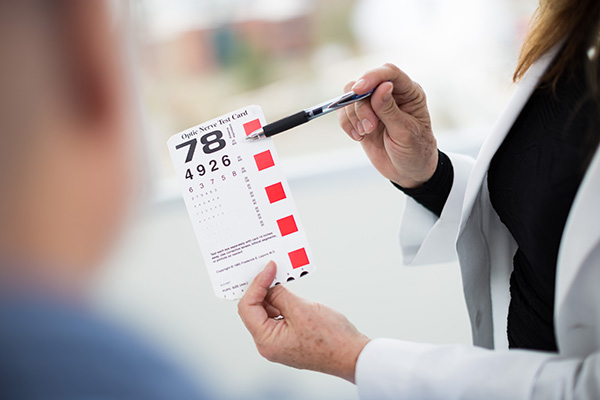Neuromyelitis Optica Spectrum Disorder (NMOSD)

The OHSU Multiple Sclerosis Center offers advanced care for neuromyelitis optica spectrum disorder, a rare nerve disorder that requires immediate treatment.
You’ll find:
- Specialists with the expertise and latest tests to give you an accurate diagnosis.
- An experienced team that will tailor a treatment plan to your needs.
- Providers who will help you manage the effects of an attack.
- A range of therapies to help you manage any longer-term symptoms.
Understanding NMOSD
Neuromyelitis optica spectrum disorder is a rare inflammatory disease that most often affects the optic nerves and spinal cord. Less often, it affects the brain. It often leads to sudden vision loss, paralysis or both. Symptoms after a first attack usually improve.
NMOSD is sometimes mistaken for MS because both have symptoms that come and go. It is also known as Devic disease or Devic’s disease.
What is NMOSD?
Neuromyelitis optica spectrum disorder is a relatively new term for a group of diseases. It includes a condition once called neuromyelitis optica as well as closely related diseases.
NMOSD is a demyelinating autoimmune disease. This means that the body’s immune system attacks the myelin, or protective sheath, around nerves.
NMOSD patterns
Relapsing-remitting NMOSD: For about 90% of patients, NMOSD is a relapsing-remitting illness, like the most common forms of MS. That means patients have attacks (relapses) that usually last days. Relapses are followed by periods of recovery (remissions) that can last weeks, months or years. Each relapse causes new damage. Over time, they can lead to serious disability.
Who gets NMOSD?
- How common is it? NMOSD is rare. Estimates vary but suggest that roughly 15,000 people in the U.S. have it. Numbers are rising as doctors become better able to diagnose NMOSD.
- Gender: The main type of NMOSD affects four to 10 times more women than men.
- Age: NMOSD strikes most often in middle age.
- Race: More white people than people of color have NMOSD. At the same time, a higher portion of people of color, especially those of Asian or African descent, are affected.
- Family history: Only about 3% of patients have a relative with NMOSD. About half have a personal or family history of another autoimmune disorder, though.
What causes NMOSD?
The root cause is unknown. NMOSD sometimes appears after an infection or along with another autoimmune condition.
Scientists do understand what happens in the body, though. The immune system produces antibodies — proteins that are normally released into the bloodstream to fight infection. But in NMOSD, the body makes an antibody called AQP4-IgG that attacks a protein that helps carry water across cell membranes.
Symptoms of NMOSD
NMOSD attacks can have serious effects, such as sudden vision loss or partial paralysis. Common symptoms include:
- Blurry vision or blindness in one or both eyes
- Weakness or paralysis in the legs or arms
- Painful spasms
- Numbness or loss of sensation throughout the body
- Persistent nausea
- Uncontrollable vomiting
- Persistent hiccups
- Bladder or bowel dysfunction
- Sleeping problems

Diagnosing NMOSD
Early diagnosis is important. Even one NMOSD attack increases the chance of lasting damage to your nervous system. At the Multiple Sclerosis Center, we bring you a detailed understanding of NMOSD so you can get the care you need.
Your team may include neurologists, radiologists (imaging specialists), rehabilitation therapists and other experts. Our diagnosis process includes:
- A full medical history and assessment of your recent symptoms.
- A neurologic exam to:
- Measure your muscle strength and coordination.
- Identify any numbness you may have.
- Assess your speech, vision, memory and thinking skills.
- An MRI (magnetic resonance imaging) to look for damage to your optic nerves, spinal cord and brain.
- A spinal tap (lumbar puncture) to examine the fluid surrounding your spinal cord and brain for signs of NMOSD.
- Eye tests to check for blurry vision or loss of color perception.
- Blood tests to look for the AQP4-IgG antibody, which is present in about 70% of NMOSD cases.
If you test positive for AQP4-IgG, your doctor may diagnose NMOSD if you have at least one of the following:
- Inflammation of your optic nerve (optic neuritis).
- Inflammation of your spinal cord (transverse myelitis).
- An episode of hiccups or nausea/vomiting with no other cause.
- A brain syndrome with lesions visible on an MRI that are consistent with NMOSD.
If you test negative for AQP4-IgG, you will be diagnosed with NMOSD only if you have optic neuritis or transverse myelitis and one other NMOSD symptom.
Treatment for NMOSD
It’s critical to treat an NMOSD attack as quickly as possible to reduce inflammation of your optic nerve or spinal cord. After a flare-up, your care team will most likely recommend ongoing care to lower the chances of a relapse.
First treatments include:
Anti-inflammatory medication: Your doctor may prescribe a course of IV corticosteroids, such as methylprednisolone, to reduce inflammation.
Plasma exchange therapy, or PLEX: This treatment may start before or shortly after you’re done with the course of steroids. In PLEX, the liquid part of your blood is separated from your blood cells and replaced with artificial plasma. This lowers the amount of AQP4-IgG antibody in your blood.
Immunosuppression medications: If inflammation persists, medications may change how your immune system reacts to inflammation and prevent new attacks. We will closely monitor you because immunosuppressants put you at higher risk for infections and other complications.
Rehabilitation therapy and complementary care
We offer rehabilitation services and other therapies to help you manage long-term issues from NMOSD. Our experts can help you with:
Spasticity (muscle stiffness and spasms): We may recommend exercises and daily stretching to keep your muscles more flexible. Medications can also help. We may suggest splints at the ankles, wrists or elbows to help you with daily activities.
Bladder and bowel problems: We can recommend a high-fiber diet and exercise to help with digestive issues. Medications can help with issues such as constipation or frequent urination.
Nerve pain: NMOSD attacks can cause long-term pain, numbness and other nerve issues. Our team can recommend medications and help you find therapies such as acupuncture and meditation. The OHSU Comprehensive Pain Center can help NMOSD patients with long-term pain and the mental health issues that often come with it.
Depression: It’s normal to feel sad or stressed after an NMOSD diagnosis. If your feelings interfere with your relationships or daily life, you may have depression that should be treated. Our team can help with counseling and medications.
Learn more
- OHSU research on MS and related disorders
- Neuromyelitis Optica Information Page, National Institute of Neurological Disease and Stroke
- Neuromyelitis Optica Spectrum Disorder, National Organization for Rare Disorders
- Neuromyelitis Optica, Guthy Jackson Charitable Foundation
- NMO FAQs, Guthy Jackson Charitable Foundation
For patients
- Referral: To become a patient, please ask your doctor for a referral.
- Questions: For questions or follow-up appointments, call 503-494-7772.
Location
Parking is free for patients and their visitors.
Center for Health & Healing Building 1, eighth floor
3303 S.W. Bond Ave.
Portland, OR 97239
Map and directions
Refer a patient
- Refer your patient to OHSU.
- Call 503-494-4567 to seek provider-to-provider advice.
Brain/nerve clinical trials
Clinical trials allow patients to try a new test or treatment.